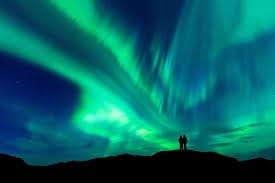Are the Northern Lights Visible Tonight?

The Northern Lights, also known as the Aurora Borealis, are one of nature’s most spectacular phenomena. They paint the night sky with ethereal displays of green, purple, and sometimes red light, mesmerizing those fortunate enough to witness them. For many, seeing the Northern Lights is a bucket list item, but catching them requires being in the right place at the right time. If you’re wondering whether the Northern Lights are visible tonight, let’s dive into what you need to know to maximize your chances of seeing this natural wonder.
What Are the Northern Lights?
Before we explore the possibility of seeing the Northern Lights tonight, let’s first understand what they are. The Northern Lights occur when charged particles from the sun collide with gases in the Earth’s atmosphere, creating colorful light displays in the sky. This interaction takes place near the magnetic poles, which is why the Northern Lights are most often visible in the polar regions.
The science behind the Northern Lights lies in solar activity. The sun continuously emits solar wind, which consists of charged particles. When these particles interact with the Earth’s magnetic field and atmosphere, they create the visual phenomenon we know as the Aurora Borealis. The most common color is green, which occurs when the solar particles collide with oxygen molecules in the Earth’s atmosphere.
Where Are the Northern Lights Most Visible?
To see the Northern Lights, you generally need to be near the Earth’s magnetic poles. In the Northern Hemisphere, the best places to view the lights include:
- Norway (Tromsø)
- Sweden (Abisko)
- Finland (Lapland)
- Iceland
- Alaska, USA
- Canada (Yukon, Northwest Territories)
These regions lie within or near the “Auroral Zone,” a band where the lights are most frequently visible. The farther you are from this zone, the lower your chances of seeing the auroras. However, under certain conditions, the lights can sometimes be seen farther south.
What Affects Visibility?
The visibility of the Northern Lights is influenced by several factors:
- Solar Activity: The sun undergoes cycles of increased and decreased solar activity. During periods of high activity, known as solar storms or geomagnetic storms, the Northern Lights are brighter and can sometimes be seen at lower latitudes.
- KP Index: The KP index measures geomagnetic activity on a scale from 0 to 9, with higher numbers indicating stronger activity. For most aurora chasers, a KP index of 4 or higher is ideal for seeing the lights.
- Weather Conditions: Even if the auroras are active, cloudy weather can obstruct your view. Clear skies are essential for aurora viewing.
- Light Pollution: Darkness is key to seeing the Northern Lights. To get the best view, you’ll need to be in an area with minimal light pollution, far away from city lights.
- Time of Year: The best time to see the Northern Lights is during the winter months, when the nights are longest. From late September to early April, locations in the Auroral Zone experience extended periods of darkness, making it easier to see the lights.
Are the Northern Lights Visible Tonight?
Now, for the question at hand: are the Northern Lights visible tonight? The answer depends on your location and the current solar activity. Here’s how you can determine your chances of seeing them:
Check the KP Index: The first step is to check the KP index, which will give you an idea of the geomagnetic activity for the night. Websites like the Space Weather Prediction Center (SWPC) or apps like Aurora Alerts provide real-time updates on the KP index and solar activity. If the KP index is above 4, you may have a chance of seeing the auroras, especially if you are in or near the Auroral Zone.
Monitor Local Weather Conditions: Cloud cover is the number one enemy of aurora chasers. Check the weather forecast for your area, and aim for a night with clear skies. The clearer the night, the better your chances of spotting the Northern Lights.
Stay Away from Light Pollution: Light pollution can significantly reduce your ability to see the Northern Lights. If you’re in an urban area, consider driving out to a more remote location where the sky is darker and free from artificial lights.
Time Your Viewing: While the Northern Lights can technically appear at any time of night, they are often most visible between 9 p.m. and 2 a.m. local time. Plan your outing accordingly, and be prepared to spend a few hours under the stars.
Use Aurora Forecasts: Several websites and apps offer Northern Lights forecasts, which predict the likelihood of auroras based on solar activity. Popular platforms include:
- AuroraWatch UK: Provides aurora alerts and visibility predictions for the UK and surrounding areas.
- Aurora Forecast: An app that tracks aurora visibility and provides notifications based on your location.
- SpaceWeatherLive: Offers real-time data on solar activity and aurora predictions.
What to Expect
Even if the conditions are right, the Northern Lights can be unpredictable. They may appear as faint, diffuse bands of light, or they could explode into bright, vibrant curtains that dance across the sky. Patience is key, and it’s important to be prepared for varying intensities of the lights.
If you’re serious about seeing the Northern Lights tonight, dress warmly and be prepared to wait in the cold for several hours. Auroras tend to come in waves, so you may experience periods of inactivity followed by sudden bursts of color. Bringing a camera with a long exposure setting can help you capture the beauty of the lights, even if they are faint to the naked eye.
What If You Don’t See the Lights?
While aurora chasing can be exciting, it’s important to manage expectations. Even if all the conditions seem right, there’s no guarantee that the Northern Lights will appear. They are a natural phenomenon, and their visibility depends on many factors. If you don’t see the lights tonight, don’t be discouraged—there will be other opportunities, especially during peak aurora season.
Conclusion
The Northern Lights are a breathtaking natural phenomenon that can be seen under the right conditions. To determine if the Northern Lights are visible tonight, you’ll need to check solar activity, the KP index, weather forecasts, and light pollution in your area. While they are most commonly seen in polar regions, strong solar storms can make them visible further south. With the right tools, a bit of luck, and some patience, you could witness one of the most magical displays in the night sky.










